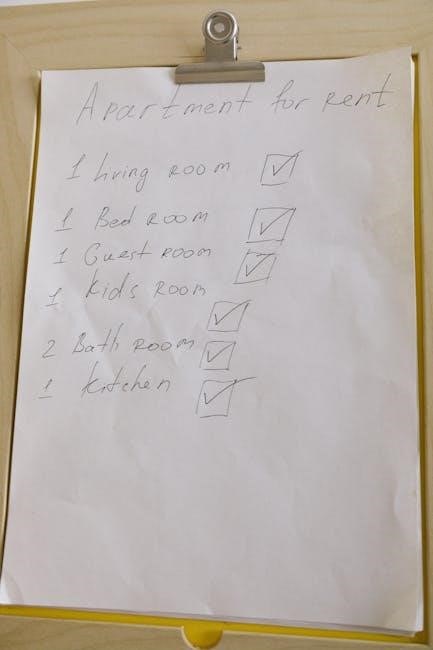
printable funeral planning checklist pdf
Printable Funeral Planning Checklist PDF: A Comprehensive Guide
Navigating funeral arrangements can feel overwhelming during grief. A printable checklist offers structured assistance, ensuring crucial details aren’t overlooked. This comprehensive guide simplifies planning, covering notifications, service personalization, and financial considerations. It streamlines decision-making, offering solace and clarity during a difficult time.
Understanding the Importance of a Funeral Planning Checklist
A funeral planning checklist is an invaluable tool during an emotionally challenging time. It provides a structured approach to managing the numerous tasks and decisions that arise after a loved one’s passing. This checklist serves as a comprehensive guide, ensuring that no critical detail is overlooked amidst the grief and stress.

The significance of a funeral planning checklist lies in its ability to organize and prioritize tasks. It helps families navigate the complexities of funeral arrangements, from immediate notifications to selecting burial or cremation options. By breaking down the process into manageable steps, the checklist reduces the feeling of being overwhelmed and promotes a sense of control.
Moreover, a well-structured checklist facilitates clear communication and collaboration among family members. It ensures that everyone is aware of the tasks at hand and their respective responsibilities. This collaborative approach minimizes confusion and potential conflicts, allowing families to focus on supporting each other and honoring the deceased.
By utilizing a funeral planning checklist, families can ensure that the funeral service reflects the wishes and personality of the deceased. It provides a framework for personalizing the service, creating a meaningful and memorable tribute to their life.
Immediate Notifications After Death
Following a death, prompt and sensitive notification of key individuals is crucial. The immediate notification process is a vital first step, demanding a balance of urgency and care. A well-prepared list of contacts ensures no one is unintentionally overlooked during this sensitive time.
The initial circle to inform includes close family members, such as spouses, children, parents, and siblings. Their immediate support and involvement are essential for making arrangements and providing emotional comfort. Next, notify other relatives, close friends, and the deceased’s employer or workplace.
Consider the most appropriate method of communication for each individual. A phone call is often preferred for close family and friends, allowing for a personal and empathetic exchange. Email or text messages may be suitable for more distant acquaintances or professional contacts. Be prepared to offer brief details about the circumstances of death and any immediate plans.
It’s also important to designate a point person to handle incoming calls and inquiries. This prevents overwhelming the immediate family and ensures consistent information is shared. Remember to update social media accounts with sensitivity and respect, avoiding premature announcements or insensitive content.
Choosing a Funeral Home
Selecting a funeral home is a critical step in the funeral planning process. This decision significantly impacts the overall experience and the quality of services provided. Start by researching local funeral homes, considering factors like reputation, location, and range of services offered. Online reviews, recommendations from friends or clergy, and professional associations can provide valuable insights.
Schedule consultations with a few potential funeral homes to discuss your needs and preferences. During these meetings, inquire about their pricing structure, available packages, and customization options. Ask about their experience with different types of services, such as traditional funerals, memorial services, or cremation arrangements.
Pay attention to the funeral director’s demeanor and communication style. Choose someone who is compassionate, respectful, and attentive to your wishes. Ensure they are transparent about costs and willing to answer all your questions thoroughly. Consider the funeral home’s facilities, including the viewing rooms, chapel, and reception areas. A comfortable and well-maintained environment can contribute to a more positive experience.
Finally, trust your instincts and choose a funeral home that aligns with your values and provides a sense of comfort during this difficult time.
Selecting Burial or Cremation Options
Choosing between burial and cremation is a significant decision with personal, religious, and financial implications. Burial involves interring the body in a casket within a cemetery plot. This option often includes costs for the casket, embalming, cemetery plot, and a burial vault. Traditional burial may appeal to those who value long-standing customs and have strong ties to a specific location.
Cremation, on the other hand, involves reducing the body to ashes through intense heat. The cremated remains can be stored in an urn, scattered in a meaningful location, or kept by loved ones. Cremation is generally more affordable than burial, eliminating the need for a casket, burial plot, and embalming (unless required for viewing). It offers greater flexibility in terms of memorialization and final disposition.
Consider the deceased’s wishes, religious beliefs, and family preferences when making this decision. Discuss the options with your chosen funeral home, as they can provide detailed information about the costs, procedures, and legal requirements associated with each choice. Ultimately, the selection should honor the deceased’s memory and provide comfort to the grieving family.
Personalizing the Funeral Service
Personalizing the funeral service transforms it from a standard procedure into a unique tribute reflecting the deceased’s life, passions, and personality. This involves incorporating elements that resonate with their character, hobbies, or achievements. Think about their favorite music, hobbies, or memorable moments. These details can create a more meaningful and comforting experience for those attending.
Consider incorporating readings of poems, excerpts from books, or personal anecdotes that capture the essence of the deceased. Displaying photos, videos, or memorabilia can evoke cherished memories and spark conversations among guests. You might include a display of their artwork, collections, or items representing their profession or interests. Encourage attendees to share stories or memories during the service, creating a sense of community and shared remembrance.
The choice of venue, decorations, and even the attire of attendees can contribute to personalization. A personalized service provides an opportunity to celebrate the individual’s life and legacy, offering solace and a lasting tribute that honors their unique spirit. It ensures the service truly represents the person being remembered.
Creating an Obituary
Crafting an obituary is a significant step in memorializing the deceased. It serves as a public announcement of their passing and a tribute to their life, offering a concise yet meaningful summary of their journey. An obituary typically includes essential details such as their full name, date of birth, and date of death. It should also mention their place of birth, significant accomplishments, and key life events.
Family members, including spouses, children, and grandchildren, are usually listed, along with any surviving siblings or other close relatives. Highlighting the deceased’s personality, interests, and hobbies can add a personal touch, painting a vivid picture for readers. Consider including anecdotes or stories that capture their unique character and contributions to their community. Mentioning their professional achievements, volunteer work, or involvement in clubs and organizations can further illustrate their impact on others.
The obituary should also include information about the funeral or memorial service, such as the date, time, and location. It may also include a request for donations to a specific charity in lieu of flowers. A well-written obituary serves as a lasting tribute and provides comfort to those who knew and loved the deceased.

Planning the Funeral Reception
The funeral reception offers a comforting space for friends and family to gather, share memories, and support one another after the funeral service. Planning this event requires careful consideration to ensure it reflects the deceased’s personality and provides a welcoming atmosphere for attendees. Start by selecting a suitable venue, such as a family home, community center, or restaurant, keeping in mind the expected number of guests and their accessibility needs. Consider the deceased’s preferences when choosing the décor and ambiance, incorporating elements that reflect their hobbies, interests, or cultural background.
Decide on the type of refreshments to serve, ranging from light snacks and beverages to a full meal, depending on the time of day and the event’s duration. Catering services can alleviate the burden of food preparation, while potluck-style gatherings encourage guests to contribute dishes, fostering a sense of community. Plan for seating arrangements that facilitate conversation and mingling, creating opportunities for guests to connect and share stories. Consider incorporating a memory table where guests can display photos, mementos, and written tributes to honor the deceased’s life.
Assign someone to manage the guest book and collect contact information, allowing the family to send thank-you notes and stay connected with attendees. The reception provides a valuable opportunity for healing and remembrance, offering a supportive environment for grieving loved ones.
Funeral Service Program Template
A funeral service program serves as a guide for attendees, outlining the order of events and providing meaningful information about the deceased. Utilizing a template simplifies the creation process, ensuring a professional and personalized keepsake. Begin by selecting a template that reflects the deceased’s personality and the tone of the service, whether it’s traditional, modern, or religious. Include a photograph of the deceased on the cover, along with their full name, date of birth, and date of death.
Inside the program, list the order of service, including musical selections, readings, eulogies, and any special tributes. Provide the names of participants, such as officiants, speakers, and musicians, acknowledging their contributions to the service. Incorporate a brief obituary or biography of the deceased, highlighting their life achievements, hobbies, and family connections. Include meaningful quotes, poems, or religious passages that resonate with the deceased’s beliefs or values. Add a personal touch by including a heartfelt message from the family, expressing gratitude for the attendees’ support and sharing fond memories of their loved one.
Consider adding a collage of photos or a timeline of significant events in the deceased’s life to further personalize the program. The funeral service program serves as a lasting tribute and a cherished memento for those who attend.
Funeral Planning Guide and Worksheet

A funeral planning guide and worksheet serve as invaluable tools for organizing and documenting essential details. These resources ensure that your wishes are honored, easing the burden on loved ones during a difficult time. The guide provides a structured framework, covering key decisions such as burial or cremation, service preferences, and memorial options. It prompts you to consider your values, beliefs, and personal style, allowing you to create a meaningful tribute.
The worksheet complements the guide, offering a practical space to record specific information. It includes sections for personal details, family contacts, funeral home preferences, and financial considerations. You can outline your desired readings, music, and visual elements, ensuring a personalized service. The worksheet also helps you estimate costs, explore funding options, and document pre-paid arrangements.
By completing the funeral planning guide and worksheet, you gain peace of mind, knowing that your wishes are clearly articulated. This thoughtful preparation alleviates stress for your family, enabling them to focus on grieving and celebrating your life. Regularly review and update your plan to reflect changing circumstances and preferences. Store the guide and worksheet in a secure location, informing trusted individuals of their whereabouts. This proactive approach ensures a smooth and meaningful funeral process.
Financial Considerations and Funeral Costs
Funeral costs can be a significant financial burden, making it essential to understand the various expenses involved. Planning ahead allows you to explore options, compare prices, and make informed decisions. Common costs include funeral home services, burial or cremation fees, casket or urn selection, memorial arrangements, and obituary notices. Additional expenses may arise from transportation, flowers, catering, and memorial keepsakes.
Financial planning for a funeral involves assessing your resources and determining how to cover the anticipated costs. Options include pre-need funeral arrangements, life insurance policies, savings accounts, and payable-on-death accounts. Explore government benefits, such as Social Security death benefits or veteran’s assistance, if applicable. Consider setting up a dedicated funeral fund to ensure sufficient resources are available.
Transparency and communication are crucial when discussing funeral costs with family members. Clearly outline your financial plan and involve loved ones in decision-making. Obtain detailed price lists from funeral homes and compare services before committing. Be aware of your rights as a consumer, and don’t hesitate to negotiate or seek alternative options. By proactively addressing financial considerations, you can alleviate stress for your family and ensure a dignified farewell without excessive debt. A printable checklist can help track expenses.
Pre-Planning Funeral Arrangements

Pre-planning funeral arrangements offers peace of mind, ensuring your wishes are honored and easing the burden on loved ones during a difficult time. It involves making decisions about various aspects of your funeral service in advance, including burial or cremation preferences, memorial service details, and financial arrangements. This proactive approach allows you to personalize your farewell and alleviate stress for your family.
The benefits of pre-planning extend beyond personal preferences; It protects your loved ones from making difficult decisions while grieving and helps avoid potential disagreements among family members. Pre-planning also allows you to control funeral costs and prevent overspending. By documenting your wishes, you ensure a service that reflects your values and beliefs.
To begin pre-planning, gather essential documents, such as your birth certificate, Social Security card, and military records. Research funeral homes and compare their services and prices. Create a detailed plan outlining your preferences for the funeral service, burial or cremation, and memorial arrangements. Discuss your plans with family members and legal advisors. Consider pre-funding your funeral through a funeral trust or insurance policy. Regularly review and update your pre-planned arrangements to reflect changing preferences or circumstances. A printable checklist can guide you through the process.
Utilizing Free Printable Templates
Free printable templates can greatly simplify funeral planning, providing structure and guidance during an emotionally challenging time. These templates offer pre-designed layouts for obituaries, service programs, checklists, and thank you cards, saving time and effort. They ensure consistency and professionalism while allowing for personalization.
Templates are available online from various sources, offering diverse designs and formats to suit different preferences. Obituary templates help organize biographical information, family details, and service arrangements. Funeral program templates provide a framework for outlining the order of service, hymns, readings, and eulogies. Checklists ensure all essential tasks are completed, from notifying family to arranging the reception. Thank you card templates offer a way to express gratitude to those who offered support.
To use these templates, download and customize them with specific details. Add photos, personalize text, and adjust layouts to reflect the deceased’s personality and preferences. Ensure all information is accurate and proofread before printing. Using free printable templates can streamline the planning process, reduce stress, and create meaningful tributes without incurring additional costs. They provide a valuable resource for families navigating funeral arrangements.